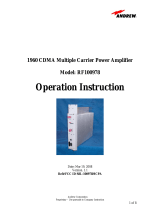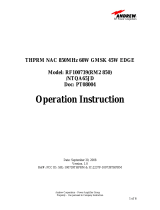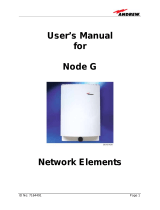
RF Power Amplifiers
Andrew Corporation – Power Amplifier Group
Propriety – Use pursuant to Company Instruction
7 of 8
threshold is typically 10.5 dB above rated input power (51.3 dBm output – 56 dB nominal
gain).
Note 5: Whenever a linearizer alarm occurs, the amplifier is shut down. Each actively
tuned gain and phase adjuster has a factory nominal setting with leash limits around it.
Whenever the tuning algorithm persistently requires an adjustment beyond the leash
limits, a linearizer alarm is declared.
Note 6: Some sensors allow fault detection because they give readings that are out of
range (e.g. temperature sensor).
Note 7: Under current or overcurrent depending on the hardware.
Note 8: Typically 10 dB to set the alarm, with 3 dB of hysteresis (alarm resets at -13 dB).
When operated with other amplifiers in parallel, each amplifier performs its own VSWR
diagnostics and shut down independently. The shutdown process is coordinated with
the RFIM and Switch Combiner Module, eliminating chain reaction scenarios.
Note 9: A VSWR critical alarm is declared when the reflected power is 80W or more and
indicates that the unit may be damaged if not shut down. Since the amplifier cannot
detect that this condition has cleared while shut down, an RF enable command, restart
command, or power cycle is required to clear this condition. Since there are circulators
on the amplifier, a delay of about 1 second is acceptable before shutting down.
Note 10: A bias fault is declared during the factory bias setting algorithm (see above) if
firmware is unable to set the bias correctly. This is typically a hard failure; however, the
bias setting command can be repeated.
Note 11: Self test: Whenever the amplifier is powered on or reset (whether from the front
panel or otherwise), firmware performs a self-test. Included in the test are processor
RAM, boot image checksum, NVM image checksum, temperature sensors, power
supplies, and pilot/receiver operation. If any one of these tests fails, a self-test failure
critical alarm is declared and the unit does not start up. There is no recovery short of a
reset or power cycle. This is typically a hard failure; however, self-test will be repeated
on the next restart command or power cycle.











